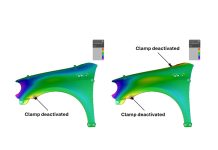Earlier this year AutoForm started this blog, “We Think In Sheet Metal”. Our goal: to communicate directly with you—the metal forming and engineering community. Here are some of our recent blog posts; please share them with your colleagues, customers, and industry peers and tell us what you think.

Which way to optimum? There may be more than one way, depending on your goals
“Which Way to Optimum?” and “Optimal Stamping Process Plans” outlines the big picture, highlighting (or identifying, supporting) our core belief that optimizing stamping process requires evaluation across multiple decision drivers that span more than one dimension—quality, costs, lead time, and function.

Best, Worst, Typical material properties? Which is real?
“Material Matters: As-shipped vs. as-engineered material” and “Why is springback worse for HSS and AHSS?” assert that the material assumptions made early on in the engineering process are very much linked to any perception of “accuracy” in FEA analysis. The articles highlight the importance of understanding the implications of the material file used in simulation, and propose some ways to better evaluate forming, knowing that material properties are highly variable in production.

http://www.automotivemanufacturingsolutions.com/process-materials/pressing-matters
“Parameters for Hot Forming and Quenching: Engineering and Design” is a short article that argues there is more to predicting the feasibility of hot stamping and quenching design than focus on the cooling channels; the process should offer ability to recognize the influence of production line constraints like robot transit time, time in tool before closing, and quenching time and forces. This article has been widely read, and has been published in three languages.
“Drawbeads and Binder Bearing” and “Options for Effective Draw Bead Modelling” introduce some of the challenges in the correct modeling of drawbeads and binder force application and feature discussion on our adaptive drawbead model.

Outer sheet metal Draw-OP engineering relies on drawbeads to achieve stretch requirements for quality stamping
“Springback Compensation: When not to try” highlights situations where springback compensation is not recommended. “Virtual Tryout and Process Engineering” challenges the industry goal of obtaining perfection in virtual tryout, noting that tryout, virtual or in press, is just the simulation of a hypothetical set of process inputs. We introduce the concept of Systematic Process Improvement as a method to arrive at a passing simulation with less trial and error, and how robust engineering can significantly improve the chances that the engineered tool performs as expected in production. “Have You Been Burned by Minimum Blank Quotes?” notes that blank predictions for crash form, progressive, and draw die forming tools are potentially very different and require some additional consideration prior to quoting based on your results.

Hyson Metal Forming Solutions, proposed using servo cushion technology to vary the binder pressure through the stroke
In the post “Infinitely Adjustable Presses: When Should We Stop Adjusting?” we share our experience in applying Systematic Process Improvement to engineer the appropriate settings for a servo (N/C) cushion controller of a servo press. “Progressive Die Developed Blank and Trimline Development” highlights our experience in achieving trimline optimization for progressive dies with developed trimlines.
Through the blog, we also share with you the experiences of our customers. We proudly feature KTH Parts Industries and the role AutoForm solutions play in their relationship with their OEM customer in “Simultaneous Engineering Case Study-KTH Parts Industries.” Our success at supporting OEMs, like PSA, with our standards definition and showcasing our unique issues-based post-processing, are featured in “Simulation Accuracy: Input Definition and Results Interpretation.”
We regularly update the blog with event announcements and news of recent AutoForm appearances and publications. If there is a topic that you’d like to see discussed, let us know. We would be delighted to hear from you. Use the comments below to join the conversation.













